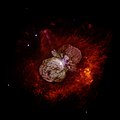טעקע:Eta Carinae.jpg
מראה

גרייס פון דעם פארויסקוק: 600 × 599 פיקצעלן. אנדערע רעזאלוציעס: 240 × 240 פיקצעלן | 480 × 480 פיקצעלן | 769 × 768 פיקצעלן | 1,025 × 1,024 פיקצעלן | 2,015 × 2,013 פיקצעלן.
ארגינעלע טעקע (2,015 × 2,013 פיקסעל, טעקע גרייס: 163 קילאבייטן, טיפ MIME: image/jpeg)
היסטאריע פֿון דער טעקע
קליקט אויף א דאטע/צײַט צו זען דאס בילד אזוי ווי עס איז דעמאלסט געווען
| דאטע/צײַט | געמינערטע בילד | געמעסטן | באניצער | באמערקונג | |
|---|---|---|---|---|---|
| לויפיק | 09:41, 18 דעצעמבער 2017 |  | 2,013 × 2,015 (163 קילאבייטן) | The NMI User | Reverted to version as of 14:14, 1 May 2008 (UTC) |
| 14:45, 13 מערץ 2017 |  | 2,998 × 3,000 (1.18 מ"ב) | Leogorgon | larger file size | |
| 14:14, 1 מאַי 2008 |  | 2,013 × 2,015 (163 קילאבייטן) | Vol de nuit | {{Information |Description=(NASA News Release) A huge, billowing pair of gas and dust clouds are captured in this stunning NASA Hubble Space Telescope image of the supermassive star Eta Carinae. Using a combination of image processing techniques (ditheri |
טעקע באַניץ
נישטא קיין בלעטער וואס ניצן די טעקע.
גלאבאלע טעקע־פארווענדונג
די פאלגנדע אנדערע וויקיס ניצן די דאזיקע טעקע:
- באניץ ביי da.wikipedia.org
- באניץ ביי en.wikipedia.org
- Star
- Eta Carinae
- Wikipedia:Selected anniversaries/March 11
- Wikipedia:Today's featured article/March 2017
- Wikipedia:WikiProject Wikipack Africa Content/Wikipedia:Showcase
- Wikipedia:WikiProject WikiFundi Content/Eta Carinae
- Wikipedia:Today's featured article/requests/Eta Carinae
- Wikipedia:Today's featured article/March 12, 2017
- Wikipedia:Main Page history/2017 March 12
- Wikipedia:WikiProject WikiFundi Content/Wikipedia:Showcase
- Wikipedia:Main Page history/2022 March 11
- Wikipedia:Main Page history/2022 March 11b
- Wikipedia:Main Page history/2023 March 11
- Wikipedia:Main Page history/2023 March 11b
- User:2003 LN6/sandbox/Eta Carinae variable
- List of luminous blue variable stars
- באניץ ביי en.wikiversity.org
- User:Marshallsumter/Radiation astronomy2/Visuals
- User:Marshallsumter/Radiation astronomy2/Violets
- Stars/Astronomy
- User:Marshallsumter/Radiation astronomy2/Violets/Quiz
- Stars/Sun/Astronomy/Quiz
- User:Marshallsumter/Radiation astronomy/Courses/Principles/Hourly 2
- User:Marshallsumter/Radiation astronomy/Courses/Principles/Final quiz
- Draft:Original research/Io/Quiz
- Titan/Quiz
- Stars/Solar systems/Quiz
- Moon/Quiz
- Earth/Quiz
- User:Marshallsumter/Radiation astronomy/Colors/Quiz
- Volcanoes/Io/Quiz
- Stars/Violets
- User:Marshallsumter/Radiation astronomy2/Stars
- Stars/Violets/Quiz
- באניץ ביי es.wikipedia.org
- באניץ ביי fr.wikipedia.org
- באניץ ביי hi.wikipedia.org
- באניץ ביי it.wikibooks.org
- באניץ ביי la.wikipedia.org
- באניץ ביי mk.wikipedia.org
- באניץ ביי ms.wikipedia.org
- באניץ ביי my.wikipedia.org
- באניץ ביי oc.wikipedia.org
- באניץ ביי ru.wikipedia.org
- באניץ ביי sk.wikipedia.org
- באניץ ביי sr.wikipedia.org
- באניץ ביי th.wikipedia.org
באקוקן נאך גלאבאלן באניץ פון דער טעקע.

